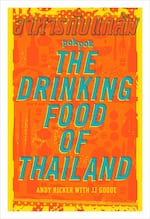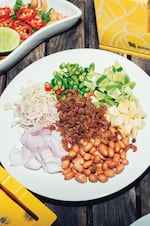"In Thailand, you drink while eating and eat while drinking," said Portland-based Andy Ricker, the James Beard Foundation award winner best known for his small family of revered Pok Pok restaurants.

The latest cookbook from the Pok Pok team explores a subset of Thai cooking called "aahaan kap klaem" (drinking food), largely unknown in the United States. Get ready for some sociable snacking and sipping!
Courtesy of Ten Speed Press
"It's the nature of the food," Ricker said. "It lingers in the mouth and you want more beer or rice whiskey. The taste is spicy hot, sour, salty. The texture — crispy, chewy. Deep-fried chicken tendons, grilled bits of offal. Green mango, a pinch of shrimp paste, a small gooseberry followed by a shot."
Ricker has relentlessly explored Thailand's eating customs and varied regional cuisines. In "Pok Pok The Drinking Food of Thailand," he and his team (co-author JJ Goode and photographer Austin Bush) focus on "aahaan kap klaem" from the northern regions. The new cookbook reveals sharp contrasts between these drinking foods and American pub food (think salted peanuts, Buffalo wings and nachos) — and the different social traditions in which they're embedded.
"In Thailand, they never drink alone," Ricker observed. "Eating and drinking is more a social event than pondering the food. It's conviviality." The book's recipes — mostly snacks, soups, chile dips, fried or grilled foods, salads and stir-fries — are not meant to be components of a proper American meal. So how can we enjoy these flavor-crazy dishes at home as the Thais do so readily in public life? A snacking mentality is key. Ricker suggests:
- Throwing a cocktail party. No cheese or liver paté. Serve a bunch of these snacks instead.
- Watching the game. Stir-fried chicken wings, fried chicken, cashews and any drink.
Documentary-style point-and-shoot photographs take you right into the street life that spawned the book. "We'd shoot at night at a roadside bar or in a stand beside a dirt road — restaurants, markets, karaokes" lit with fluorescent bulbs, said Ricker. They ordered what they wanted and "shot the food directly, no styling," using a hard flash. "Then we ate it."
Afterward, Ricker would recreate the recipes as closely as possible. "These dishes are quickly put together. Dopey simple."
A book-signing and tasting is scheduled from 5:30 to 7:30 p.m. Dec. 14 at Providore Fine Foods in Northeast Portland.
The team's next book, on noodle dishes from all regions of Thailand, is due out next fall.
What To Drink With 'The Drinking Food'
"Thailand is a rice whiskey country," Ricker said.
"The Thai working class — they work their butts off, so they drown their sorrows at the end of the day. In the countryside, they make very little. One beer is expensive. If two guys share it, no one is getting drunk. Rice whiskey is cheaper — four guys can get drunk." Does this essential accompaniment to "aahaan kap klaem" (Thai drinking food) translate to the United States, where beer is the working person's drink?
"Americans would find some of the Thai rice whiskeys unpleasant — harsh, medicinal," said Ricker. He suggests Soju, a Korean liquor sold in 750 mL and 1.75 liter bottles. Ricker uses Jinro brand, 24 percent alcohol, distilled from 55 percent sweet potato, 35 percent tapioca and 10 percent barley.
"What makes it more pleasant is when you make 'lao saparot' (macerate fresh pineapple in the soju, strain, serve). However, there's nothing wrong with serving it straight in shots — that's probably more true to the culture experience."
Ricker also suggests trying Shochu, a Japanese beverage "similar in taste, relatively low proof, meant for sipping." Brands at a Portland neighborhood OLCC store ranged from 25 to 56 percent alcohol. Three were distilled from 17 percent rice and 83 percent sweet potatoes. Soju and Shochu were shelved with the cordials.

Kai Saam Yang (Chicken Three Ways) does not contain chicken, or meat of any kind – it's just a few raw ingredients piled on a plate. The versions Portlander Andy Ricker came across in northern Thailand did not contain shrimp, either, but he added it for interest.
Copyright by Austin Bush
Kai Saam Yang (Chicken Three Ways)
2 to 4 servings
Prep: 15-20 minutes (plus 15 minutes for shrimp) | Easy (if you can cut an onion with a $3 knife, you have enough skill for this dish)
"The first thing you need to know about kai saam yang, or "chicken three ways," is that the snack does not contain chicken — or any meat, for that matter. The name reportedly came about during a time when chicken was scarce, when you ate what you had and cracked jokes to endure the lot life brought. The second thing you need to know is that while the English translation makes it sound like an overwrought creation served at some Michelin-starred restaurant, the dish itself is utterly rudimentary: a collection of raw ingredients chopped or sliced, piled on a plate, and eaten with a spoon — one intense bite at a time. Basic though it is, the flavors are evocatively Thai and represent drinking food at its finest.
I've eaten many versions in Thailand, from the extremely simple (just peanuts, lemongrass, and shallots) to the merely very simple (additions of Thai chiles, ginger, and peel-on pinkie-tip-size garlic cloves). I've heard of versions made with crunchy fried bugs, no great stretch in Thailand and a reasonable source of protein when poultry is unavailable. The recipe here is for my preferred combination, which you'll discover makes a compulsively delicious snack with any booze, whether you mix all of the ingredients together, eat each separately, or something in between.
Executing this recipe is a no-brainer. Still, you can up your game by choosing small hands of thin-skinned ginger and smooth, glossy-skinned limes. The former tend to be less fibrous, and the latter tend to have less pith and more juice than their dull, rough-peel counterparts. That's all the better, of course, since you're eating both of them raw, and in the case of the lime, with the peel and pith intact." — Andy Ricker
Ricker's tips
- Shop for ingredients at Asian stores such as Lily Market, Fubonn Supermarket or Hong Phat in Portland and at Hispanic markets.
- For the peanuts: Buy raw from the bulk-foods bin and toast in neutral oil on the stovetop over medium heat or roast on a pan in the oven; finish with sea salt or kosher salt. Or buy packaged at Trader Joe's.
Ingredients
- 2 Key limes, or 1 regular (Persian) lime
- 17 grams / 2 tablespoons diced (1/4 inch / 6 mm) peeled Asian shallots
- 16 g / 2 tablespoons diced (1/4 inch / 6 mm) peeled fresh ginger
- 12 g / 2 tablespoons sliced (1/4 inch / 6 mm) fresh Thai chiles, preferably red
- 14 g / 2 tablespoons thinly sliced (1/8 inch / 3 mm) lemongrass (tender parts only)
- 40 g / 1/4 cup salted roasted Spanish (red-skinned) peanuts
14 g / 2 tablespoons Kung Haeng Khua (Dry-fried dried shrimp), see recipe below
To prepare
Wash the limes especially well, since you'll be eating the peel as well as the flesh. Cut off both ends of each lime to reveal the flesh, and stand a lime on one of the flat ends. Cutting from the top to the bottom and following the contour of the fruit, cut off pieces 1/4 inch / 6 mm thick that include both the peel and the flesh, then cut the pieces into 1/4-inch / 6-mm dice. Repeat with the second lime. You'll need 20 g / 2 tablespoons diced lime for this recipe. Reserve the remainder for another use.
Arrange the lime, shallots, ginger, chiles, lemongrass, peanuts, and shrimp each in its own pile on a small plate. Serve with spoons.
Kung Haeng Khua (Dry-fried dry shrimp)
Prep: 15 minutes | Easy
Makes 35 grams / 1/3 cup
"Most Asian grocery stores stock different sizes of dried shrimp loose or in bags. Look for medium-size (sometimes you’ll just see the letter M on the bag) for the recipes in this book. Toasting them brings out their complex flavor and makes them pleasant to chew." — Andy Ricker
Ingredient
- 45 grams / 1/2 cup medium-size dried shrimp, soaked in water for 10 minutes, then drained
To prepare
Briefly rinse the drained shrimp and pat them dry. Heat a small dry pan or wok over medium heat, add the shrimp, and cook, stirring frequently, until they are dry all the way through and slightly crispy, 5 to 8 minutes. Set them aside to cool completely.
The dry-fried shrimp will keep in an airtight container at room temperature for up to 1 week.
Republished with permission from "POK POK The Drinking Food of Thailand” by Andy Ricker with JJ Goode, copyright 2017. Photography by Austin Bush. Published by Ten Speed Press, an imprint of Penguin Random House.